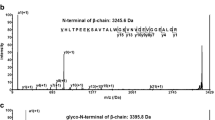Abstract
Quantification of human hemoglobin (Hb) is essential for diagnosis of anemia, especially for screening for thalassemia and sickle cell disease. The main methods currently used for quantification of Hb, including spectrophotometry, fluorimetry, and electrochemical assays, are all based on the structural integrity of Hb, which could be affected by hemolysis and degradation. When used for disease screening, whole blood specimens cannot meet requirements for sample collecting, transport, and storage. Here, we report a novel MS–MS method for quantification of Hb from dried blood spots (DBS) by use of a triple-quadrupole mass spectrometer. Proteospecific peptides from α-globin chains were selected after tryptic digestion. The precursor → product ion transitions of representative peptides were studied to identify the best choice with regard to sensitivity and chromatographic properties. For quantification, stable isotope-labeled peptides were used as internal standards. The concentration of Hb in each sample was obtained by calculation on the basis of established equations. The precision of the method was within 15 % and accuracy was in the range −7 to 13.0 %. Compared with routine clinical results obtained by use of the automated hematology analyzer (AHA) assay, the correlation, r 2, was >0.993. When used for determination of anemia levels the sensitivity of the assay was 95.7 % and specificity 96.5 %. Our new approach for quantification of the concentration of Hb from DBS is feasible, and precision is acceptable. The method could be used for determination of anemia levels when screening for hemoglobin disorders.

Quantification of human hemoglobin from digested dried blood spot samples using tandem mass spectrometry





Similar content being viewed by others
References
Anand I, McMurray JJ, Whitmore J, Warren M, Pham A, McCamish MA, Burton PB (2004) Circulation 110:149
Forget BG, Bunn HF (2013) Cold Spring Harb Perspect Med 3:a011684
Broadway-Duren JB, Klaassen H (2013) Crit Care Nurs Clin North Am 25:411
Rago A, Latagliata R, Montanaro M, Montefusco E, Andriani A, Crescenzi SL, Mecarocci S, Spirito F, Spadea A, Recine U, Cicconi L, Avvisati G, Cedrone M, Breccia M, Porrini R, Villiva N, De Gregoris C, Alimena G, D'Arcangelo E, Guglielmelli P, Lo-Coco F, Vannucchi A, Cimino G (2015) Leuk Res 39:314
Bettati S, Viappiani C, Mozzarelli A (2009) Biochim Biophys Acta 1794:1317
Morgner F, Lecointre A, Charbonniere LJ, Lohmannsroben HG (2015) Phys Chem Chem Phys 17:1740
Guthrie R, Susi A (1963) Pediatrics 32:338
Lindstrom B, Ericsson O, Alvan G, Rombo L, Ekman L, Rais M, Sjoqvist F (1985) Ther Drug Monit 7:207
Petrini C, Olivieri A, Corbetta C, Cerone R, D'Agnolo G, Bompiani A (2012) Ann Ist Super Sanita 48:119
Zytkovicz TH, Fitzgerald EF, Marsden D, Larson CA, Shih VE, Johnson DM, Strauss AW, Comeau A, Eaton MRB, Grady GF (2001) Clin Chem 47:1945
Chace DH, Kalas TA, Naylor EW (2002) Annu Rev Genomics Hum Genet 3:17
Gucciardi A, Pirillo P, Di Gangi IM, Naturale M, Giordano G (2012) Anal Bioanal Chem 404:741
Wild BJ, Green BN, Cooper EK, Lalloz MR, Erten S, Stephens AD, Layton DM (2001) Blood Cells Mol Dis 27:691
Rai DK, Griffiths WJ, Landin B, Wild BJ, Alvelius G, Green BN (2003) Anal Chem 75:1978
Basilico F, Di Silvestre D, Sedini S, Petretto A, Levreri I, Melioli G, Farina C, Mori F, Mauri PL (2007) J Mass Spectrom 42:288
Daniel YA, Turner C, Haynes RM, Hunt BJ, Dalton RN (2007) Clin Chem 53:1448
Boemer F, Ketelslegers O, Minon JM, Bours V, Schoos R (2008) Clin Chem 54:2036
Boemer F, Cornet Y, Libioulle C, Segers K, Bours V, Schoos R (2011) Clin Chim Acta 412:1476
Moat SJ, Rees D, King L, Ifederu A, Harvey K, Hall K, Lloyd G, Morrell C, Hillier S (2014) Clin Chem 60:373
Karimi M, Cohan N, De Sanctis V, Mallat NS, Taher A (2014) Pediatr Hematol Oncol 31:583
Mairbaurl H, Weber RE (2012) Compr Physiol 2:1463
Wood WG (1976) Br Med Bull 32:282
Schechter AN (2008) Blood 112:3927
Winichagoon P, Svasti S, Munkongdee T, Chaiya W, Boonmongkol P, Chantrakul N, Fucharoen S (2008) Transl Res 152:178
Peri S, Steen H, Pandey A (2001) Trends Biochem Sci 26:687
Shrivastava A, Gupta VB (2011) Chronicles Yong Sci 2:21
Acknowledgments
This work was supported by grants from the National Natural Science Foundation of China (21305165, 81373444), and the Key Project Foundation of Health Ministry, Chongqing (2012-1-049). We would like to thank all the patients and their families for their cooperation and interest in this study.
Conflict of interest
All authors declare no competing financial interest.
Author information
Authors and Affiliations
Corresponding author
Electronic supplementary material
Below is the link to the electronic supplementary material.
ESM 1
(PDF 665 kb)
Rights and permissions
About this article
Cite this article
Yu, C., Zhang, J., Yuan, Z. et al. A novel method for quantification of human hemoglobin from dried blood spots by use of tandem mass spectrometry. Anal Bioanal Chem 407, 8121–8127 (2015). https://doi.org/10.1007/s00216-015-8988-4
Received:
Revised:
Accepted:
Published:
Issue Date:
DOI: https://doi.org/10.1007/s00216-015-8988-4




